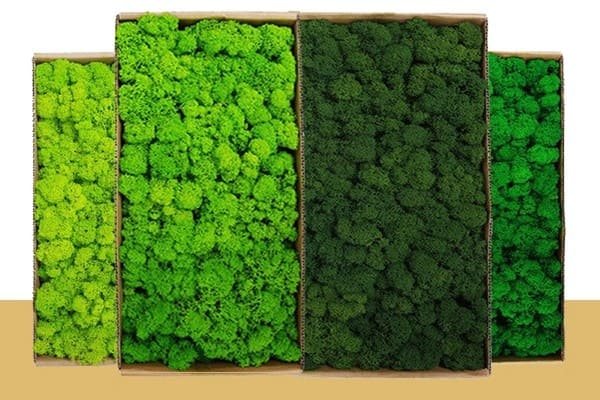


As the world becomes more focused on sustainability and environmental consciousness, green building certifications such as LEED (Leadership in Energy and Environmental Design) and BREEAM (Building Research Establishment Environmental Assessment Method) have become increasingly important. These certifications encourage and reward building practices that reduce environmental impact and promote energy efficiency, water conservation, and indoor environmental quality.
Preserved moss is emerging as a popular material in sustainable design, particularly in the context of green building certifications. Not only does preserved moss contribute to the aesthetic appeal of interior spaces, but it also offers a range of environmental benefits that can enhance a building's sustainability profile. This article will explore the role of preserved moss in green building certifications, its environmental advantages, and how architects, designers, and builders can leverage preserved moss to achieve higher green certification scores.
Preserved moss is natural moss that has been treated with a special preservation process to maintain its texture, color, and flexibility without the need for ongoing maintenance. The preservation process typically involves replacing the moisture in the moss with a plant-based glycerin solution, which keeps the moss soft and pliable. Unlike live moss, preserved moss does not require sunlight, water, or soil to thrive, making it an ideal material for use in interior design and vertical gardens.
Preserved moss is available in various types, including reindeer moss, sheet moss, bun moss, and pole moss, each with unique textures and colors. Its versatility allows it to be used in a wide range of design applications, from green walls and vertical gardens to decorative accents in office spaces and public buildings.

Green building certifications provide a standardized way to measure the environmental performance of a building. They focus on several key areas, including energy efficiency, water conservation, waste reduction, indoor air quality, and sustainable material use. These certifications encourage the adoption of environmentally friendly building practices, which can reduce a building's carbon footprint, lower operating costs, and create healthier indoor environments for occupants.
Preserved moss offers several environmental benefits that can contribute to a building's green certification score. These benefits align with the goals of various certification programs, such as LEED and BREEAM, and can help architects and designers create sustainable, eco-friendly spaces.
Indoor air quality is a major consideration in green building certifications, as it directly impacts the health and well-being of building occupants. Preserved moss can play a role in improving indoor air quality by acting as a natural air purifier. While preserved moss does not engage in photosynthesis like live plants, it can still help absorb pollutants and dust particles from the air, creating a cleaner and healthier indoor environment.
Preserved moss is often used in vertical garden installations or green walls, which are designed to improve air quality in enclosed spaces. These green walls can help reduce the concentration of indoor air pollutants, including volatile organic compounds (VOCs) and carbon dioxide, leading to a healthier work or living environment.
Biophilic design, which emphasizes the connection between humans and nature, is an important aspect of green building certifications, particularly in the WELL Building Standard. Biophilic design aims to create spaces that incorporate natural elements to promote the physical and mental well-being of occupants. Preserved moss, with its lush green appearance and organic texture, is a perfect material for biophilic design.
Vertical gardens or moss walls made from preserved moss can be used to bring the outdoors inside, creating a calming and restorative environment. Studies have shown that exposure to natural elements, even in the form of preserved plants, can reduce stress, improve concentration, and enhance overall well-being.
One of the key goals of green building certifications is to reduce energy consumption. While preserved moss does not actively contribute to energy savings in the same way that solar panels or energy-efficient windows might, it can indirectly support energy efficiency by reducing the need for artificial air purification and ventilation systems.
In buildings with preserved moss installations, the natural air-purifying properties of the moss can help improve air circulation and quality, reducing the need for energy-intensive HVAC systems. Additionally, preserved moss does not require artificial lighting, water, or other resources, making it a low-impact, energy-efficient material for interior design.
Green building certifications prioritize the use of sustainably sourced and environmentally friendly materials. Preserved moss is a sustainable option because it is harvested from natural environments, typically under controlled conditions that prevent overharvesting and promote ecosystem health.
The preservation process used for moss is also eco-friendly, as it involves the use of non-toxic, biodegradable materials. By choosing preserved moss for vertical gardens, designers can reduce the environmental impact of their projects and meet the requirements for sustainable material use in green building certifications.
Water conservation is a critical component of green building certifications, particularly in regions where water is a scarce resource. Live plants in vertical gardens or green walls require regular watering, which can be resource-intensive in certain climates. Preserved moss, on the other hand, requires no water at all, making it an ideal choice for projects where water conservation is a priority.
By using preserved moss instead of live plants, architects and designers can create beautiful green spaces without contributing to excessive water use. This can be particularly beneficial in achieving LEED credits related to water efficiency.
LEED certification is one of the most sought-after green building certifications, and preserved moss can help a project earn points in several key areas:
LEED emphasizes the importance of indoor air quality, natural lighting, and occupant comfort. Preserved moss installations can contribute to the IEQ category by improving indoor air quality and supporting biophilic design principles. The use of preserved moss in green walls or other interior applications can create a more pleasant and healthier indoor environment, which is a key consideration for achieving LEED certification.
The Sustainable Sites category in LEED evaluates how well a building interacts with its surrounding environment. Vertical gardens featuring preserved moss can help reduce the urban heat island effect by cooling the air in and around the building. Additionally, using preserved moss reduces the need for water and energy consumption, further supporting the goals of this category.
The Materials and Resources category in LEED focuses on sustainable material sourcing, waste reduction, and the use of environmentally friendly building products. Preserved moss qualifies as a sustainable material because it is harvested from natural environments using eco-friendly practices. Its long lifespan and low environmental impact make it an excellent choice for projects aiming to earn LEED points in this category.
Water efficiency is a critical component of LEED certification, particularly in arid regions. Because preserved moss does not require any watering, it supports the goals of water conservation and efficiency. Projects that use preserved moss in place of live plants in vertical gardens or green walls can earn points in the Water Efficiency category.

When integrating preserved moss into a green building project, there are several key considerations to keep in mind:
Preserved moss offers a range of environmental benefits that can support green building certifications such as LEED and BREEAM. Its ability to improve indoor air quality, support biophilic design, and reduce water and energy use makes it an ideal material for sustainable building projects. By incorporating preserved moss into vertical gardens, green walls, or other design elements, architects and designers can create beautiful, eco-friendly spaces that contribute to a healthier planet and higher certification scores Preserved moss is not only a practical and sustainable material but also a versatile one.